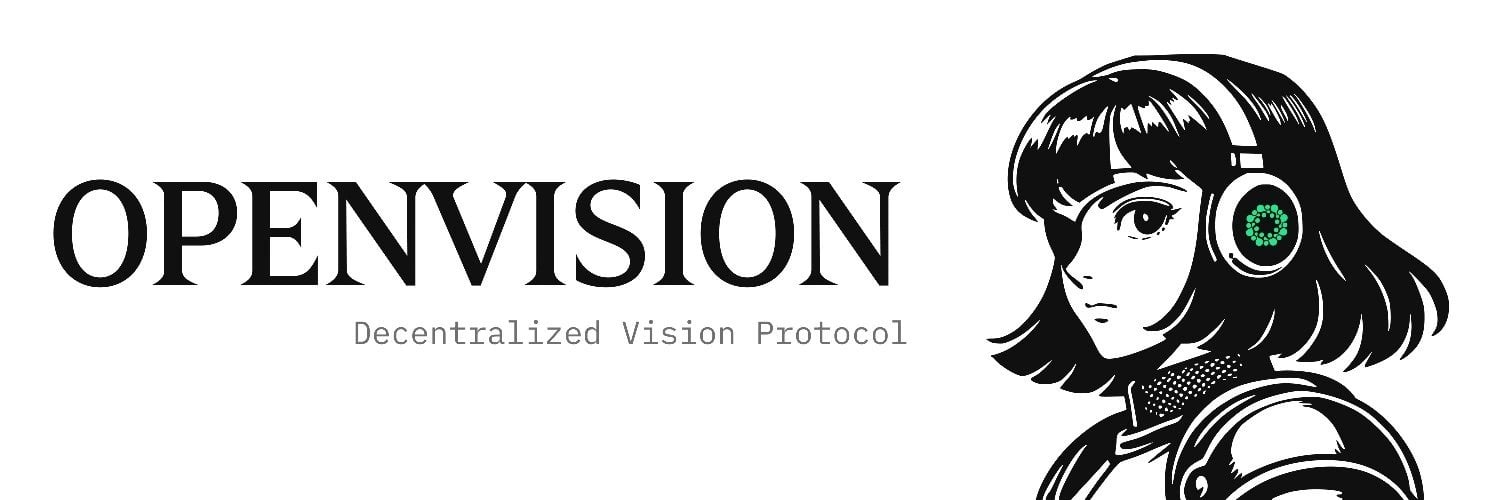OpenVision
OpenVision is a decentralized research collective focused on advancing machine perception through the use of real-world video data and community-provided computing resources. It operates as a self-funded team dedicated to artificial intelligence, edge infrastructure, and visual intelligence. [1]

Overview
OpenVision is a decentralized infrastructure protocol designed for developing, training, and deploying Vision Language Models (VLMs) across a permissionless network. It combines distributed computing, real-world data streams, and a custom Layer 1 blockchain to support visual AI applications in areas like robotics, autonomous systems, IoT, and edge devices.
Its core model, Parallax, is trained on video data from global contributors and updated through decentralized compute nodes. Participants in the network contribute GPU resources, data, and validation, receiving $VISION tokens in return. OpenVision integrates Ethereum for governance and transparency, a private VisionX L1 chain for vision-focused smart contracts, and a Modular Compute Protocol (MCP) for distributing training workloads. [2]
Technology
Parallax
Parallax is a modular Vision Language Model (VLM) developed through crowdsourced training and decentralized fine-tuning, incorporating elements from Vision Transformers (ViT), CLIP, and SAM-like attention mechanisms to enable real-time spatial reasoning and contextual understanding. It integrates multimodal inputs such as image, text, and geospatial metadata to support a range of applications, including lane detection and object recognition in autonomous vehicles, depth estimation and environment mapping in robotics, anomaly detection and crowd analytics in surveillance, and real-time image parsing in AR/VR and IoT systems. [3]
VisionNode
VisionNode is a desktop and browser-based application that enables user devices with cameras to function as training or inference nodes within the network. It uploads video streams from sources like dashcams or CCTV, benchmarks system resources such as GPU, RAM, and uptime, and assigns tasks accordingly. Based on the device's specifications, VisionNode supports both model inference and fine-tuning workloads. [4]
VisionSync
VisionSync is a distributed training protocol that divides large model training processes into smaller micro-tasks. It allocates these tasks based on factors such as hardware capacity, contributor reputation, and the type of data involved. The system includes built-in validation mechanisms with redundancy and supports zero-knowledge machine learning (zkML) for added verification. [5]
VisionX
VisionX is a modular Layer 1 blockchain designed for high-throughput coordination of vision-related AI workloads. It features a task auction and execution engine tailored to vision applications, along with smart contracts that manage rewards, model checkpoints, and validator governance. The chain supports sub-second finality and is optimized for handling frequent AI tasks, including task pricing and zero-knowledge machine learning proofs, offering greater efficiency than general-purpose L1 chains. [6]
Modular Compute Protocol
The Modular Compute Protocol (MCP) enables decentralized AI training by distributing micro-tasks across VisionNodes based on system capabilities. It utilizes a reputation system that scores contributors on task completion, uptime, and latency, while task results are verified through quorum consensus or fallback zero-knowledge machine learning (zkML) proofs. MCP includes a scheduling mechanism to balance workloads and prevent node overload, and enforces penalties, such as token slashing and reputation reduction, for incorrect or malicious behavior. [7]
VISION
The $VISION token functions as the core utility asset within the OpenVision ecosystem, supporting protocol operations, governance, and contributor incentives. VISION has a total supply of 1B tokens. It is used for computing payments, access to premium training modules, governance participation, and priority access to tasks. A portion of API and training job revenue is automatically used to buy and burn $VISION, introducing a deflationary mechanism tied directly to protocol usage. Enterprises that opt to pay in USDC face additional fees unless holding a minimum $VISION balance, reinforcing token demand. Token burn rates and further reductions can be governed through DAO proposals based on network performance and token supply conditions. [8]
Staking mechanisms further embed $VISION into protocol operations by incentivizing long-term token lockups, which grant higher rewards, governance influence, and premium access to compute tasks. Contributors can stake tokens for durations between 1 and 36 months, with reward tiers determined by stake amount, lockup length, and historical performance. Validator nodes face slashing penalties for low-quality output or misconduct, maintaining system integrity while linking reliability to staked capital. These systems collectively tie $VISION to the growth, reliability, and decentralization of OpenVision’s infrastructure. [9]
Vision DAO
OpenVision’s governance operates through a decentralized autonomous organization (DAO) that manages protocol development and ecosystem oversight. Stake-weighted voting allows token holders to propose and vote on changes such as upgrades, reward structures, and treasury allocations using on-chain tools. Community members can submit suggestions using standardized proposal templates, and voting power may be delegated to experts for curated decision-making. The DAO also manages treasury funds for research grants, community projects, and reserves, with control enforced through multi-signature and on-chain mechanisms. Governance is designed to gradually transition from the core team to the community based on predefined milestones. [10]
Partnerships
- Arcadia
- Gradient
